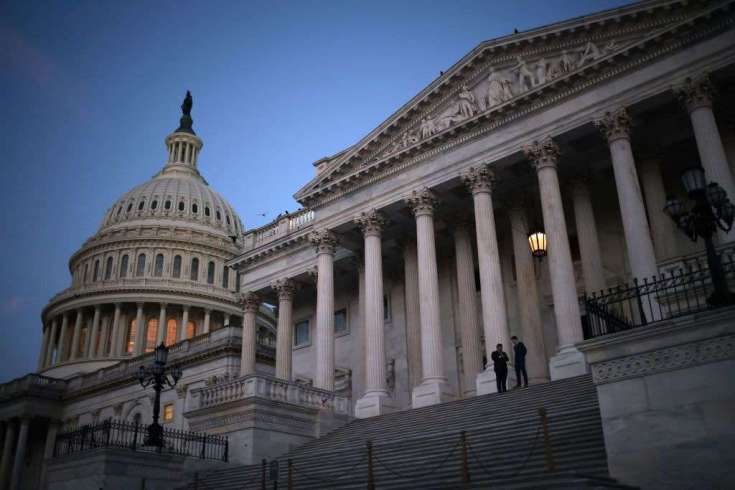
Win McNamee | Getty Images News | Getty Images
Higher taxes for the rich edged closer to reality on Wednesday morning, after Senate Democrats passed a $3.5 trillion budget plan along party lines.
The blueprint would raise taxes on wealthy Americans and corporations and beef up tax enforcement to fund additional spending on education, paid leave, childcare, health care and climate initiatives, according to a framework issued Monday.
That outline offers scant detail on specific tax policy relative to the wealthy, saying only that it seeks “tax fairness for high-income individuals.”
But it’s likely the richest Americans will face higher taxes on their ordinary income, capital gains from investments and appreciated assets bequeathed to heirs, according to tax experts.
More from Personal Finance:
Social Security cost-of-living adjustment could be 6.2% in 2022
What the federal debt ceiling means to your wallet
Vaccine passports gain traction as delta variant threatens travel rebound
The plan would also “prohibit” new taxes on families making less than $400,000 a year, small businesses and family farms.
At the same time, the spending plan — which paves the way for formal legislation that Democrats can pass without Republican votes — may also give a tax break to some wealthy individuals in high-tax states. It suggests Democrats will offer “relief” on the current $10,000 cap on state and local tax deductions.
Of course, placating all Democrats, who have razor-thin margins in the Senate and House, may prove tough relative to tax policy and could complicate their agenda.
“At this point, we’re dealing with Monopoly money,” said Bill Hoagland, a senior vice president at the Bipartisan Policy Center. “It’s when we actually start putting rubber to road that this’ll become a heck of a lot more difficult.”
Taxpayers who earn more than $500,000 paid about 70% of total individual income taxes collected this year, Hoagland said, citing tax-return data.
Income taxes
Raising the top marginal income-tax rate to 39.6%, from the current 37%, is the most likely way Democrats intend to raise taxes on the wealthy, according to experts.
“I think Democrats would say, ‘That’s where we were before the [2017 Tax Cuts and Jobs Act] that we didn’t vote for. That’s not asking too much,'” said Ryan Abraham, a principal at Ernst & Young who sits on the firm’s Washington Council.
Democrats would essentially be fast-tracking current policy — the top rate on ordinary income is already set to revert to 39.6% after 2025, per the Tax Cuts and Jobs Act.
As a result, the average tax rate paid by those who earn $500,000 to $1 million a year would increase to about 31% (from 27%), according to Hoagland. It would rise to 32.5% (from just over 30%) for those with income of more than $1 million, he said.
The change would raise $131 billion in federal revenue through 2026, according to a U.S. Department of the Treasury estimate issued in May.
Boosting the capital gains tax
There’s also an expectation that the top tax rate on long-term capital gains will rise.
The Biden administration proposed raising that top rate to 39.6% — the same as the proposed top rate on ordinary income — for those who earn more than $1 million a year. (Combined with a 3.8% surtax on net investment income, the top federal rate would be 43.4%.)
Wealthy individuals get a big portion of their annual income from investments — meaning raising taxes just on wages may not tax their total income as effectively as Democrats might like, according to experts.
Those with annual income of more than $1 million get about 40% of income from investments, compared with just 5% for people who earn less than $50,000 a year, according to the Tax Foundation.
However, some experts are skeptical Democrats will be able to raise the rate on long-term capital gains (which are owed on investments held for over a year) to 39.6%.
“I’d expect some increase, bringing it closer to the individual rate,” Hoagland said. “But not all the way to the individual rate at all.”
Wealthy estates
RubberBall Productions | Brand X Pictures | Getty Images
Democrats will likely also try to change how appreciated assets held by the wealthy are passed on to heirs.
The White House, for example, proposed imposing a capital-gains tax at death, with some exceptions.
“That would be a much bigger change than just changing the capital-gains rate,” Abraham said of the proposed policy.
Currently, an asset’s appreciation isn’t taxed upon an owner’s death. The asset gets a step-up in basis, meaning it transfers to heirs at its current market value, erasing the capital gain. Heirs could then sell the asset free of capital-gains tax.
(Super-wealthy estates owe a 40% federal estate tax under current law, on values exceeding $11.7 million for individuals and $23.4 million for married couples.)
Reforms to capital-gains taxes would raise $322.5 billion over a decade, according to a Treasury estimate.
Tax enforcement
Democrats are also eyeing tax compliance to raise revenue from households earning more than $400,000 a year.
Underreported income, largely among the wealthy, is the biggest contributor to the so-called tax gap, according to a Treasury report issued in May.
The Treasury estimated the gap (the difference between tax paid and tax owed) to be $584 billion in 2019. About 80% of the gap comes from “opaque income sources,” such as partnerships, proprietorships and rental property, that accrue mostly to the rich, Treasury said.
The Biden administration has called for more third-party reporting to the IRS to improve tax compliance.


